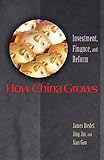How China Grows : Investment, Finance, and Reform / Jian Gao, Jing Jin, James Riedel.
Material type: TextPublisher: Princeton, NJ : Princeton University Press, [2020]Copyright date: ©2007Description: 1 online resource (224 p.) : 72 line illus. 18 tablesContent type:
TextPublisher: Princeton, NJ : Princeton University Press, [2020]Copyright date: ©2007Description: 1 online resource (224 p.) : 72 line illus. 18 tablesContent type: - 9780691220185
- Finance -- China
- BUSINESS & ECONOMICS / Development / Economic Development
- "as
- Asian financial crisis
- Cao, Yuanzheng
- China Statistical Yearbook
- Europe
- Fan, Xiaohang
- Germany
- H-shares
- Hong Kong
- Johnson, Samuel
- Kaminsky, Graciela
- Kuijs, Louis
- Levine, Ross
- M2 measurement
- N-shares
- Naughton, Barry
- Solow growth model
- agriculture
- asymmetric bonds
- banks
- bond market
- capital-labor ratio
- decentralization
- dollar peg
- elasticity
- financial sector
- household saving
- impossible trinity
- individual enterprises
- investment
- loans
- migration
- paper tigers
- policy banks
- regression analysis
- swap centers
- tax farming system
- urban sector
- 330.951 22
- online - DeGruyter
| Item type | Current library | Call number | URL | Status | Notes | Barcode | |
|---|---|---|---|---|---|---|---|
 eBook
eBook
|
Biblioteca "Angelicum" Pont. Univ. S.Tommaso d'Aquino Nuvola online | online - DeGruyter (Browse shelf(Opens below)) | Online access | Not for loan (Accesso limitato) | Accesso per gli utenti autorizzati / Access for authorized users | (dgr)9780691220185 |
Frontmatter -- Contents -- Preface -- Acknowledgments -- CHAPTER 1. Overview of Economic Reforms and Outcomes -- CHAPTER 2. The Source of Growth and the Role of Investment -- CHAPTER 3. Saving and the Financing of Investment in China -- CHAPTER 4. Financial Sector Repression -- CHAPTER 5. Banking Sector Reform -- CHAPTER 6. Developments in the Bond Market -- CHAPTER 7. The Rise and Fall of the Stock Market -- CHAPTER 8. Macroeconomic Policy and Performance -- References -- Index
restricted access online access with authorization star
http://purl.org/coar/access_right/c_16ec
Although China's economy has grown spectacularly over the last twenty-five years, economists disagree about how the Chinese economy is likely to fare in the short- and long-term future. Is China's growth sustainable, or has China relied too much on investment, which is subject to diminishing returns, and not enough on technological change? The first book on the relation between investment, finance, and growth in China, How China Grows dismisses this concern. James Riedel, Jing Jin, and Jian Gao argue that investment has not only been the engine of growth, but also the main source of technological progress and structural change in China. What threatens future growth instead, the authors argue, are the weaknesses of China's financial system that undermine efficiency in investment allocation. Financial-sector reform and development are necessary, not only for sustaining long-term growth, but also for maintaining macroeconomic stability. Although it includes some technical economic analysis, How China Grows is accessible to noneconomists and will benefit anyone who is interested in development finance in general and in China's economic growth in particular--whether economists, political scientists, bankers, or business people.
Mode of access: Internet via World Wide Web.
In English.
Description based on online resource; title from PDF title page (publisher's Web site, viewed 30. Aug 2021)


